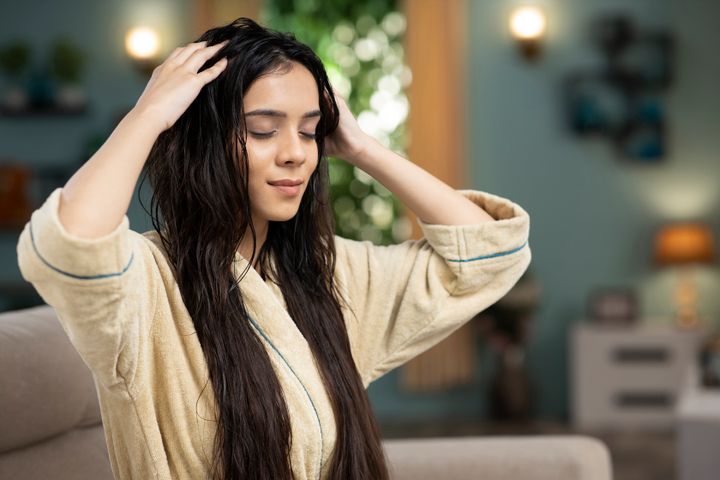
Hair and beauty aficionados or watchers of Bridgerton might have noticed something in the way of a ‘hack’ – that of applying oil on the scalp to stimulate healthy hair growth.
The trick has been garnering attention on social media, with the moniker ‘hair slugging’ and ‘hair oiling’ taking hold on TikTok.
This describes the art of rubbing a penetrative oil (as opposed to a hair shine or non-greasing oil) and massaging it around the head.
And now it’s gone mainstream – amassing more than 35.8 million views and counting, with many touting it as a new and revolutionary method set to change your hair game.
But actually, it’s not new at all. South Asians have been practicing ‘hair slugging,’ or a thel maalish as we know, it for centuries.
We even saw it on Bridgerton as Edwina had her hair lovingly massaged by her sister on the hit Netflix show, an ode to a 5,000-year-old tradition, started through the Indian science of Ayurveda.
Many South Asians still adhere to the ritual, including me, and it’s probably what contributes to our lush, long tresses in the community – in fact, India is the top global supplier of human hair to be made into wigs, so clearly we’re getting healthy hair right.
For many, a thel malish holds many significances, including nostalgia, special moments with a loved one, or even difficult memories that were overcome.
For me, the smell of one particular brand (Amla thel, for those who are familiar), evokes the strongest memories of my late grandmother, whose hair was always sleeked back with the thel, the fragrance adorning her saree. When I catch a whiff of it, I’m bought back to wonderful memories of her.
So, seeing products like Amla thel lined up in Superdrug and the like under ‘deep conditioning treatments’ feel somewhat uncanny.
I’m glad we have more options to buy items like this in the mainstream, and that the practice is gaining recognition for all its benefits. But it’s not a new thing started by beauty influencers and mammoth brands.
For many, the easy acceptance of this trend when it’s boosted by Western content creators and brands, but was shunned when we went to school with greasy hair, sparks difficult feelings.
Many were bullied for greasy hair and internalised shame and embarrassment for adhering to a cultural practice. Others, as children, hated having to sit still as their mother or another matriarch (it’s usually practiced by women) thoroughly (and painfully if you have curly hair) rubbed the oil from their fingertips to the scalp in circular motion.
Now, we’d be glad to get a thel maalish from a loved one. And it’s cool that we can simply pop down to a local drug store to pick one up.
We only wish it was normal to mask your hair in oil back in the day too, and that it’s now given credit where credit is due.
Because South Asians truly do have enviable hair.